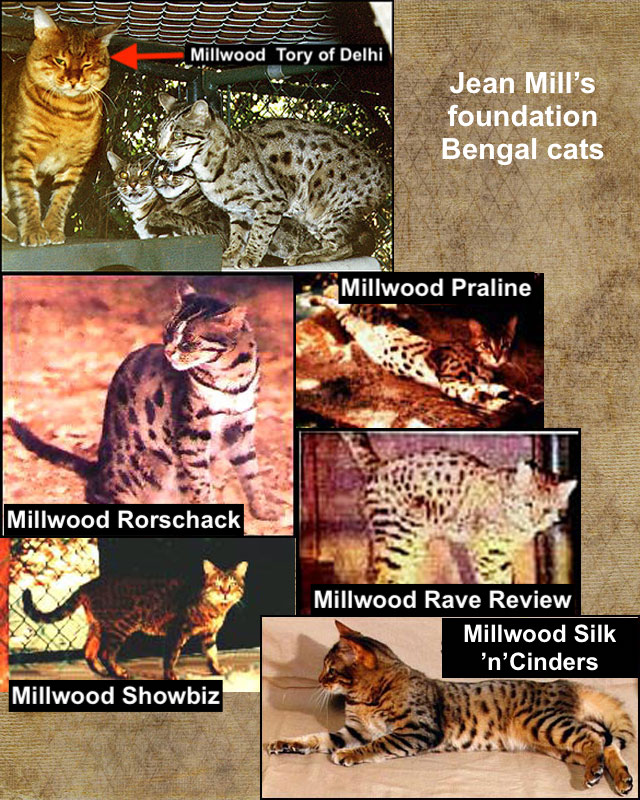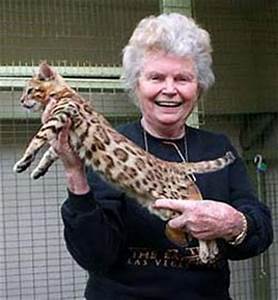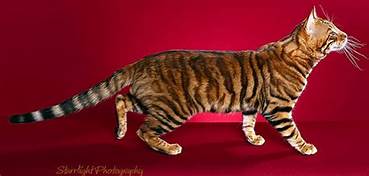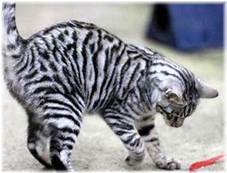

Jean Mill
(1926 - 2018)

'''Jean Mill''' (May 11, 1926 – June 7, 2018) was cat breeder, and a conservationist who worked to protect the Asian leopard cat. Mill is best know as the founder of the modern Bengal cat breed: Mill successfully crossed the wild Asian leopard cat with a domestic cat, and then Backcrossing|backcrossed the offspring through five generations to create the domestic Bengal. Mill made contributions in two other cat breeds: the[Himalayan cat|Himalayan and the standardized version of the Egyptian Mau. Jean and her first husband Robert Sugden were involved in a precedent-setting case about the United States government's power to monitor short wave radio communications. Jean Mill has also authored two books.

Conservation efforts and breeding rationale
Jean Mill was very concerned about the hunting and poaching of the Asian Leopard cats to supply the fur trade. Mill has said that her desire to save the Asian Leopard cat led to the creation of the Bengal cat breed.
"I deliberately crossed Leopard cats with domestic cats for several important reasons. At this time, wild cats were being exploited for the fur market. Nursing female leopard cats defending their nests were shot for their pelts, and the cubs were shipped off to pet stores worldwide. Unsuspecting cat lovers bought them unaware of the danger, their unpleasant elimination habits and the unsuitability of keeping wild cats as pets. ...I hoped that putting a leopard coat on a domestic cat the pet trade could be safely satisfied. If fashionable women could be dissuaded from wearing furs that look like their friend' pets the diminished demand would result in less poaching of wild species." Jean Mill
Himalayan cat contributions
In 1948, Jean Mill worked to develop the Himalayan cat, a longhaired breed of mixed Persian cat and Siamese cat ancestry. (1) She said she originated the breed by 1954 and was showing off her prizewinning cats by 1960. ( 2) Jean Mill said, "I pursued the dream, and was among the early contributors to the Himalayan breed. I gave a presentation to the ACFA board in March of l965 in Texas asking that they be recognized, but the board was half Persian breeders, the other half Siamese breeders, none of whom liked the idea of mixing the two! When the Himalayans lost their challenge, it was time to move on." (3)
Creating the Bengal Breed
There were many other breeders involved in developing the Bengal breed, most notably Pat Warren, William Engle and Willard Centerwall. Jean Mill is considered the originator of the breed because she created a domestic Bengal past the F4 generation, and then tirelessly promoted the new breed. (4)
1960s: Mill's First Hybrid Cat
While living in Yuma Arizona in 1963, Mill (Jean Sugden) made the first recorded deliberate cross of a domestic tomcat with a wild Asian leopard cat. (5) The Asian leopard cat|leopard cat Mill used was a spotted five to twelve pound shy wild cat species from Asia. Jean Sudgen purchased a female Asian Leopard cat (named Malaysia) from a pet store in 1961. She put a black domestic tomcat in her cage. The animals mated and produced two kittens, a male and a female called KinKin. (4) This was the first effort to use hybrid offspring to create a breed of domestic cat with the loving nature of a favored fireside tabby and the striking look associated with Leopards, Ocelots and Jaguars. (6)

1970's The cats which became the foundation cats for Jean Mill
In 1970 Mill resumed her breeding efforts and in 1975 she received of a group of Bengal cats which had been bred for use in genetic testing at Loyola University New Orleans by Dr. Willard Centerwall. In the 1970's Dr. Willard R. Centerwall, professor of pediatrics and director of genetics services at Loma Linda University, conducted genetic research with the offspring of the Asian leopard cat (Fells bengalensis) and the American domestic cat (Felis calus). The Asian leopard cat does not have the feline leukemia virus built into its system, scientists in cancer research were interested in what happens to the leukemia genome in the offsprings of the leopard cat and the domestic cat. (7) When Dr. Centerwall concluded his studies he gifted the cats from the study to Jean Mill. Eventually, these same hybrids were instrumental in the Bengal breed's development. Through a mutual contact, Dr. Centerwall and Jean Sugden Mill met in 1980. Centerwall had several F1 kittens needing homes and he gave them to Jean Mill. (8)
1982 Spotted domestic cats from India
In 1982 Mill found a spotted domestic cat in a pound. And then on a trip to India in 1982, she saw another spotted domestic cat "running around the rhinoceros compound" in a zoo. "He was an orange cat with little spots all over him," Mill said. "He was so unusual, I asked the zookeepers to catch him for me
The pound cat (Finally Found) and the Indian street urchin (Millwood Toby of Delhi) were bred with the lab cats, and the Bengal cat line began to form. (9) The curator of the New Delhi Zoo also gave Mill the sister of the cat in the rhinoceros cage which Mill named Tasha of New Delhi. These two Indian domestic cats Toby and Tasha contributed greatly to the Bengal breed.
Egyptian Mau Breeding
Mill registered Millwood Tory of Delhi as an Egyptian Mau. Mill also imported other Egyptian Mau kittens from India. Mill also needed males to stud the F1 and F2 kittens resulting from the Asian Leopard cat since hybrid males are often sterile. Mill also used Egyptian Maus to raise her F1 Bengal kittens. Several Egyptian Mau breeders, used Millwood Tory of Delhi 'Indian Mau' genes to improve upon the weak, inbred, poor tempered, poor producing bloodlines. In 1985 Jean Mill's Egyptian Mau line was retracted by the Cat Fanciers' Association. Eventually they all reinstated and the bloodline is now used extensively in modern Egyptian Maus. (3)
Bengal Cat Breeding Resumed
Mill combined her spotted domestic cats with the Centerwall cats and with that Mill was able to restart her Bengal breeding program: where others breeders had failed to get the Bengal breed established because of the sterility of the F1,F2, F3, and F4 early generation Bengals, Jean Mill succeeded. Mill successfully backcrossed Bengals until she achieved the F5 Bengal with a domestic cat temperament. The modern Bengal breed traces to cats bred by Jean Mill in the early 1980's. (10) (1) Others also began breeding Bengals – and in 1986 The International Cat Association (TICA) accepted the Bengal cat as a new breed: Bengals gained championship status in 1991. (6) Where other early Bengal breeders Like William Engle only succeeded in creating a sterile hybrid, Jean Mill succeeded in creating a Domestic Bengal cat. (11)
Jean Mills Cattery was Called "Milwood"
Education
Jean Mill earned a degree from Pomona College in psychology in 1945. Mill attended graduate classes in genetics at [[UC Davis]] in 1946. At U.C. Davis Mill wrote a term paper which proposed crossing the popular Persian breed of cat with the new Siamese breed to make 'Panda Bear' cats. (1)
Personal life
Jean Mill was born May 14, 1926 in Des Moines. Mill moved to California to attend college and by 1948 was one of three breeders working to develop the Himalayan cat, a Longhaired cat|longhaired breed of mixed Persian cat and Siamese cat ancestry. (1)
Jean Mill married a wealthy rancher and cotton farmer named Robert Sugden and moved to his ranch in Yuma, Arizona. (12) When he died in 1965, she move into an apartment and put her conservation/breeding efforts on hold. The Sugden's had a daughter named Judy in 1948.
Jean Mill got married a second time to John Krummel and together they lived in Pomona, California until they divorced.
In 1975, Mill married engineer Robert J. Mill March 1, 1978 in Los Angeles County, California, and moved to his one-acre horse property in Covina Hills, California. (1) Jean Mill and Bob Mill continued to live in California and they bred Bengal cats under the name Millwood. Bob Mill died September 21, 1999.
Death & Legacy
Jean Mill died Mill died June 6, 2018. Her conservation efforts are part of her legacy. Jean Mill created a domestic Bengal cat with markings like a leopard and the temperament of a house cat in order to protect wild cats from overhunting. It is unknown what impact the Jean Mill's Bengal cat breed had on the fur industry. It is known that fur fell out of fashion in the United States. "More than 60% of Americans find killing animals for fur amounts to cruelty, according to an Angus Reid survey." (13)
As of 2019, Bengal breeders number in the thousands.
Jean Mill got the Bengal cat accepted into TICA in 1986.
Since that time Bengals have been accepted into all of the cat registries:

Judy Sugden was the daughter of Jean Mill (maiden name Jean Sugden). Jean Mill succeeded in creating the Domestic Bengal cat.(16)
Jean Mill also inspired her daughter Judy Sugden to create a new cat breed, the Toyger. (13)
It has been said that all glitter in the Bengal cat, Egyptian Mau and Toyger breeds originates from cat that Jean Mill found in India: Millwood Tory of Delhi.(17)
Bengals come in different patterns marbled, spotted, Rosetted, Domestic cats have four distinct and heritable coat patterns – ticked, mackerel, blotched, and spotted – these are collectively referred to as tabby markings.[21] However, Bengals have a wide variety of markings and colors. The most popular colour is the Brown spotted/rosetted Bengal. Even within the Brown spotted/rosetted category a Bengal can be: red, brown, black, ticked, grey, spotted, rosetted, clouded. Many people are stunned by the Bengal Cat's resemblance to a leopard. Among domestic cats, the Bengal markings are perhaps the most varied and unique and Bengals come in a variety of coat colors.[18][19] The International Cat Association (TICA) recognizes several Bengal colors. Brown Spotted, Seal Lynx Point (snow), Sepia, silver, and Mink Spotted Tabby Bengals.[20]
Toygers have same frame as bengals but totally striped and as far as I am aware, there are only two colours brown and silver at present.





Toyger History
The Toyger is a relatively new breed that has been developed by Judy Sugden. The breed began its development in the 1980s. Even though the breed resembles a tiger the breed has no ‘wild blood’ and has been created by merely selectively breeding for cats with distinct markings that resemble a tiger.
The breed started when Judy Sugden noticed distinctive markings on her tabby’s face which is usually free of any markings. Sugden used this shorthaired tabby named ‘Scrapmetal’ and a bengal named ‘Millwood Rumpled Spotskin’. She then imported a tomcat from the streets of India that had distinct spotted markings between his ears. From here Sugden developed a breeding programme with the help of breeders Anthony Hutcherson and Alice McKee. In 1993 the toyger was accepted for registration by The International Cat Association, and by 2007 they were accepted as a championship breed.
Books
Further reading
*{{cite book |title=Bengal Cats. Bengal Cat Owners Manual. Guide to Owning a Happy Bengal Cat |first1=Steve |last1=Richardson
|edition=Illustrated |publisher=Amazon Digital Services LLC, Kdp Print Us |year=2015 |isbn=1910617555 |id=ISBN 9781910617557}}{{self-published inline|date=March 2019}}
References
1. Hamilton, Denise (March 10, 1994). "A Little Cat Feat: A Covina woman's efforts at cross-breeding wild and domestic felines are paying off handsomely". Los Angeles Times. p. 2. Retrieved January 27, 2019.
2. "Queen Jean Sugden Raises Himalayan Cats". The Yuma Daily Sun. January 11, 1960. p. 5. Retrieved 2019-03-29.
3. Mill, Jean S. "Milestones at Millwood". Millwood Bengals. Jean Mill. Retrieved March 16, 2019.
4. Jean S., Mill (1998). Guide to Owning a Bengal Cat. Neptune City, NJ: TFH Publications. p. 159. ISBN 978-0-7938-4663-4.
5. Jones, Joyce (September 20, 1992). "The Pet Cat That Evokes the Leopard". The New York Times. Retrieved January 23, 2019.
6. "Bengal Breed". TICA. The International Cat Association. Retrieved March 8, 2019.
7. "Leukemia Hereditary Factors Under Probe By Researcher". The Desert Sun. Palm Springs. Calif. –. April 19, 1977. Retrieved March 8, 2019.
8. "BENGAL CAT ORIGINS". Bengals Illustrated. Award Winning Publications. Retrieved March 8, 2019.
9. McEnroe, Collin (June 28, 1993). "WILD THING? NO, BENGAL'S A SWEET CAT". Hartford Courant. Retrieved March 9, 2019.
10. "About the Bengal". CFA. The Cat Fanciers' Association, Inc.,. Retrieved March 8, 2019.
11. Barrington, Kate. "A Detailed History of the Bengal Cat Breed". Bengal Cats. Bengal Cats. Retrieved March 8,2019.
12. "Wealthy Arizonan Faces Charge". Hamilton Journal – The Daily News (67). October 8, 1953. Retrieved March 19,2019.
13. FERAL, PRISCILLA. "Torture goes out of fashion: Momentum builds for a ban on NYC fur sales". Daily News. New York: New York Daily News Inc. Retrieved March 16,2019.
14. Miller, Kenneth (February 23, 2007). "Hello, Kitty: Inside the making of America's next great cat". The Pantagraph. p. 77. Retrieved 22 March 2019.
15. material curtesy from https://www.paintedcats.com/jean-mill-.html
16. Barrington, Kate. "A Detailed History Of The Bengal Cat Breed". Bengal Cats. Bengal Cats. Retrieved 8 March 2019.
17. Hutcherson, Anthony (1 April 2019). "Glitter". TICA Trend. 40 (3): 8.
18. "Bengal Breed". Tica.org. The International Cat Association. Retrieved 5 January 2020.
19. "So, Do You Think My Cat Is a Bengal?". WildcatSanctuary.org. Sandstone, Minnesota: Wildcat Sanctuary. 2019. Retrieved 23 January 2019.
20. Brown, Alan. "Bengal Cats & Kittens". BengalCat.com. The International Cat Association. Retrieved 12 September 2013 – via The International Bengal Cat Society.
21. Barsh, Greg; Kaelin, Christopher (2010). "Tabby pattern genetics – a whole new breed of cat". Pigment Cell & Melanoma Research. John Wiley & Sons, Inc. 23 (4): 514–516. doi:10.1111/j.1755-148X.2010.00723.x. PMID 20518859.